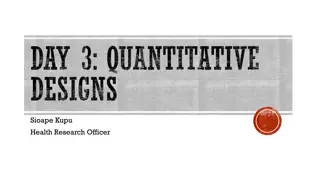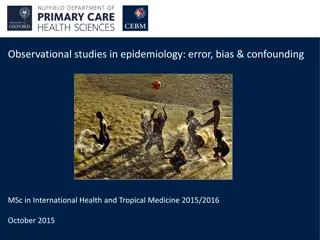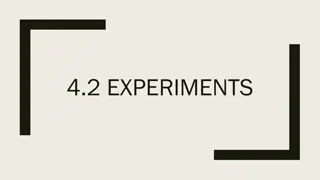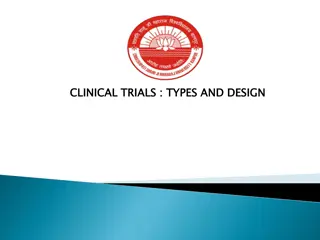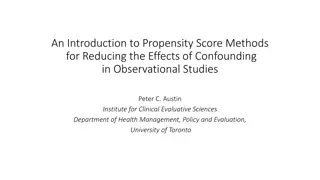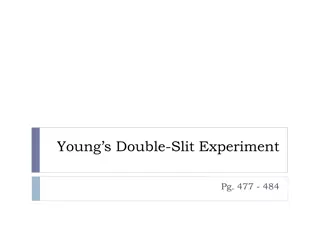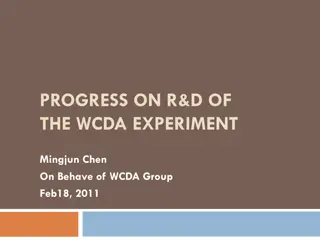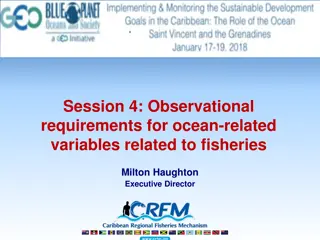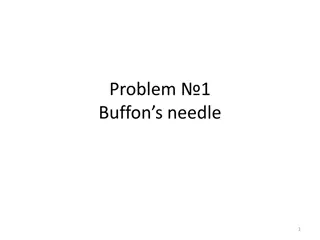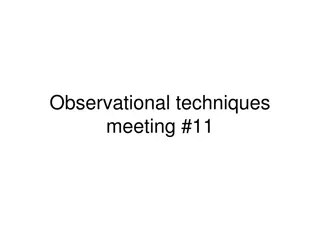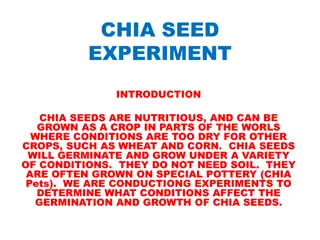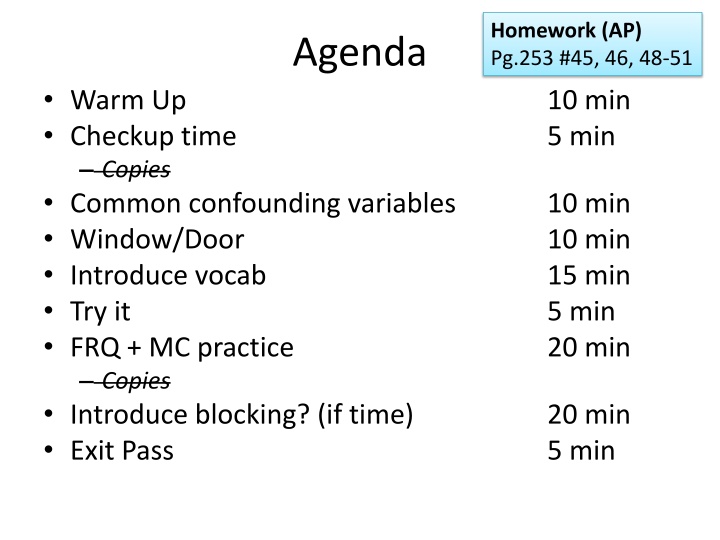
Advanced Placement Homework and Statistical Analysis Agenda
Explore a comprehensive study agenda covering homework assignments, statistical analysis problems, a warm-up exercise, checkup time, understanding common confounding variables, and sampling methods. Engage in practice exercises and learning activities to enhance understanding. Discover statistical concepts through real-world examples and apply them to solve practical problems.
Download Presentation

Please find below an Image/Link to download the presentation.
The content on the website is provided AS IS for your information and personal use only. It may not be sold, licensed, or shared on other websites without obtaining consent from the author. If you encounter any issues during the download, it is possible that the publisher has removed the file from their server.
You are allowed to download the files provided on this website for personal or commercial use, subject to the condition that they are used lawfully. All files are the property of their respective owners.
The content on the website is provided AS IS for your information and personal use only. It may not be sold, licensed, or shared on other websites without obtaining consent from the author.
E N D
Presentation Transcript
Homework (AP) Pg.253 #45, 46, 48-51 Agenda Warm Up Checkup time Copies Common confounding variables Window/Door Introduce vocab Try it FRQ + MC practice Copies Introduce blocking? (if time) Exit Pass 10 min 5 min 10 min 10 min 15 min 5 min 20 min 20 min 5 min
n=21 Warm Up These are the expected and actual scores for last year s Unit 4 test (out of 28). 1. What do you expect to get on next week s test? 2. According to these data, what will you actually get? 3. Let s say you really get 24.5. What is your residual? 4. If a classmates residual is 2.95, and they expected to score 23, what did they actually score? EXPECTED (x) ACTUAL (y) 7 18 20 20 20 21 21 21 21 22 23 24 24 24 24 25 25 26 27 27 27 17 16 21 23.5 18 22 16.5 25 23 14.5 21 25 23.5 20 17.5 27.5 23 27 24 17.5 23.5
EXPECTED (x)ACTUAL (y) 7 18 20 20 20 21 21 21 21 22 23 24 24 24 24 25 25 26 27 27 27 17 16 21 23.5 18 22 16.5 25 23 14.5 21 25 23.5 20 17.5 27.5 23 27 24 17.5 23.5 These are the expected and actual scores for last year s Unit 4 test (out of 28). 1. What do you expect to get on next week s test? VARIES 2. According to these data, what will you actually get? After removing (7,17) as an outlier, use equation y=0.529x + 9.2833 3. Let s say you really get 24.5. What is your residual? Plug in your answer to #1, then subtract the predicted y from 24.5. 4. If a classmates residual is 2.95, and they expected to score 23, what did they actually score? Plug in 23 to get predicted 21.4503. y-21.4503 = 2.95. y=24.4003
Window/Door 1. Window. Name and briefly summarize all three bad sampling methods. 2. Door. Briefly describe a situation where you would want to use stratified sampling. 3. Window. Briefly describe a situation where you would want to use SRS. 4. Door. Briefly describe a situation where you would want to use cluster sampling. 5. Window. Briefly describe a situation where you would want to use systematic sampling.
Common confounding variables Placebo effect Many subjects respond to any treatment, even fake ones Example: H. K. Beecher evaluated 15 clinical trials concerned with different diseases. 35% of 1,082 patients were satisfactorily relieved just by placebo (Beecher, 1955) SOLUTIONS: Control group a group of patients who receive no treatment. Compare results with treatment group(s) Blinding patients do not know which group they are in Experimenter bias Many experiments want their hypotheses to be confirmed SOLUTION: Double-blinding patients and experimenters do not know groups when giving treatments
Example Gastric freezing is a safe and easy treatment for ulcers in the upper intestine, and has been widely used for many years. Patients swallow a deflated balloon with tubes attached, then a refrigerated liquid is pumped through the balloon to relieve ulcers. The Journal of the American Medical Association reported that gastric freezing reduced acid production and ulcer pain in 34% of patients. When a control group received a placebo (at body temperature), 38% had reduced acid production and ulcer pain.
Notes 1 of 2 Why randomize? For confounding variables you DON T know Some researchers try to control all confounding variables Not a good idea! Don t trust your own judgment. Instead, use randomness to reduce (not eliminate) confounding effects. Large sample = better randomization
Try it! Design an experiment to answer the following: Windows Do push-ups increase upper-body strength? Doors Do certain colors make people hungrier?
The Paper Airplane Experiment Which type of paper makes the best paper airplane? Stock, Printer, Graph paper. Partners. 20 minutes. 1. Do an experiment. Be quiet outside my classroom. If I get in trouble from a coworker, I will destroy you be upset. 2. Windows On whiteboard, listall confounding variables you controlled. 3. Doors On whiteboard, list 2+ confounding variables you didn t control for. 4. Share with classmates.
Which paper type was best? Let s vote: Stock Graph Printer 10 5 12
Variables you controlled Folder/creator Folding style/design Location/environs of throw Thrower Double-blind
Quotes But I suck at making paper airplanes .. I think we want to make them all the same. Oh crap, the lined paper has holes. Let s make three of each! Should I make all of them, to be consistent? I can t control how hard I throw. We don t need a yardstick. What does best mean?
The Language of Experiments Pgs 233-235, orange book, ~5-10 minutes Start at The Language of Experiments , stop at How to Experiment Badly Vocabulary you need to know: 1. Treatment 2. Experimental unit 3. Subject 4. Factor 5. Level
Example A physical education instructor wants to compare the percentage of body fat for joggers, cyclists, and swimmers. She also wants to compare the percentage of body fat for vegetarians and meat-eaters. Let s assume you do an experiment. 1. What is the response variable(s)? 2. What is the factor(s)? What are its levels? 3. What are the treatments?
Level A Level B Factor 1 Treatment 1A/2A Treatment 1B/2A Treatment 1C/2A Level C Treatment 1A/2B Treatment 1B/2B Treatment 1C/2B Level A Factor 2 Level B RESPONSE
LEVELS FACTORS Run Swim Type of exercise Meat runner Meat swimmer Meat biker Bike Veggie runner Veggie swimmer Veggie biker Veggie Diet Meat % body fat
Window/Door (EASIER) Consider the experiment that you just performed with your partner. Identify the following: 1. Experimental units. 2. Are the experimental units also subjects? Justify. 3. Factor(s) 4. Levels 5. Treatments 6. Response variable
Window/Door (TOUGHER) A recent study in Nature suggests that people can wake up quickly just by talking to other people (Retsim & Nagilloc, 2014). The researchers asked a group of college-age males and a group of college-age females to sleep for only 3 hours, then had all the students talk to an assistant for 5 minutes, 1 minute, or 0 minutes. The high-talk group reported more alertness after the talking, and scored higher on a cognitive awareness test. Females within that group scored higher than the males, but did not report more alertness. Identify the following: 1. Experimental units. 2. Are the experimental units also subjects? Justify. 3. Factor(s) 4. Levels 5. Treatments 6. Response variable
Practice with FRQs & M.C.s Round One FRQ practice, verbal only. DOOR Textbook, pg. 275 #T4.12 Windows have answers. Help/correct as appropriate. WINDOW Pgs. 275-276 #T4.13 Doors have answers. Help/correct as appropriate. DOOR Pg. 276 #T4.14, skip part (a) Round Two Multiple-choice, written. Pages 274-275 #T4.1-4.11 Skip #4.2, 4.5, 4.10 Write answers in notebook, to remember.
Blocking Notes 2 of 2 Confounding variables you DO know 1. You reasonably suspect a confounding variable 2. You didn t use stratified sampling Blocking Everything has that characteristic equally, then randomize within your block(s) Example: Does sunscreen prevent sunburn? (diagram, next slide) Block of high-melanin subjects, block of low-melanin subjects. Among high-melanin, randomly assign sunscreen/no-sunscreen. Among low-melanin, randomly assign sunscreen/no-sunscreen. Do Cheerios lower cholesterol? Matched-pair design is most common blocking Each pair can be blocked for same age, sex, income, etc.
EXAMPLE (sunscreen) Let s say you have 28 people. 18 people darker skin 10 people lighter skin Randomly assign Randomly assign 5 5 9 9 sunscreen no sunscreen sunscreen no sunscreen If you put sunscreen on people with darker skin, do they burn less? If you put sunscreen on people with lighter skin, do they burn less?
Blocking Notes 2 of 2 Confounding variables you DO know 1. You reasonably suspect a confounding variable 2. You didn t use stratified sampling Blocking Everything has that characteristic equally, then randomize within your block(s) Example: Does sunscreen prevent sunburn? (diagram, next slide) Block of high-melanin subjects, block of low-melanin subjects. Among high-melanin, randomly assign sunscreen/no-sunscreen. Among low-melanin, randomly assign sunscreen/no-sunscreen. Do Cheerios lower cholesterol? Matched-pair design is most common blocking Each pair can be blocked for same age, sex, income, etc.
140 155 156 166 173 174 185 192 193 194 195 199 208 219 Example: Matched Pairs Let s say you have 28 people. You want to see if Cheerios lowers cholesterol, and you want to control for pre-existing cholesterol. You measure all participants cholesterol (mg/dL), then pair them up as close as possible. 220 220 221 228 244 248 249 249 251 259 261 268 269 278 140 155 156 166 173 174 185 192 193 194 195 199 208 219 220 220 221 228 244 248 249 249 251 259 261 268 269 278 Randomly assign one person in each pair to eat Cheerios. See if their cholesterol goes down more than their partner .
Blocking Notes 1 of 1 Confounding variables you DO know 1. You reasonably suspect a confounding variable 2. You didn t use stratified sampling Blocking Everything has that characteristic equally, then randomize within your block(s) Example: Does sunscreen prevent sunburn? (diagram, next slide) Block of high-melanin subjects, block of low-melanin subjects. Among high-melanin, randomly assign sunscreen/no-sunscreen. Among low-melanin, randomly assign sunscreen/no-sunscreen. Do Cheerios lower cholesterol? Matched-pair design is most common blocking Each pair can be blocked for same age, sex, income, etc.
Door/Window Imagine you ve selected a simple random sample of 100 adult residents in West Sacramento. For the research question below, 1. What s a reasonable confounding variable to block for? 2. How would you do it? DOORS Does red wine reduce the risk of heart disease? WINDOWS Does Vitamin C prevent the common cold?
Homework (AP) Pg.253 #45, 46, 48-51 Exit Pass An April 7, 2000 survey from the Davis Enterprise, headlined City people are more prone to illnesses states that City dwellers get sick more often than their rural counterparts. These trends were drawn from a five-year study by the Centers for Disease Control and Prevention. 1. Imagine you are planning a similar study, and want to sample 100 people. Name and describe the method you d use to choose those 100 people.

